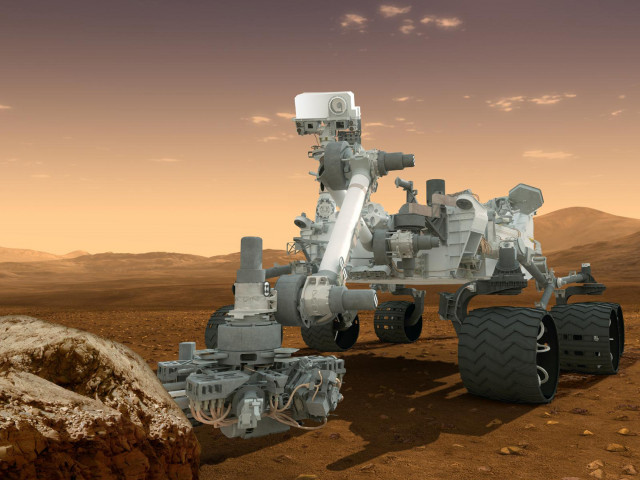Curiosity's second day on Mars 'flawless': NASA
It is the biggest robot ever built for planetary exploration.

"We feel very confident we have a lot of data capacity now, that we have all these links, and that was one of the major objectives of that first part of the mission," mission manager Jennifer Trosper told reporters at a press conference at the Jet Propulsion Laboratory in Pasadena, California.
She added that a pair of cameras - set like two large eyes on the newly extended remote sensing mast - will be used Thursday to give scientists their first full-color panoramic 360-degree view around the rover.
NASA released a low resolution black and white panoramic Wednesday that shows a vast sediment-covered plain, with low mountains in the distance.
"The first impression you get is how earth-like this seems," commented John Grotzinger, a scientist for the mission.
"All those materials are derived from the erosion of those mountains," he added, explaining that the sediments were brought down into the crater by water that once pooled there.
These signs of water on Red Planet hint that some form of life was once likely - even though Mars is now a dry place with a thin atmosphere, extreme winters and dust storms - and they're Curiosity's reason for being.
The nuclear-powered rover is designed to hunt for soil-based signatures of life on the Earth's nearest neighbor and send back data to prepare for a future human mission.
It is the biggest robot ever built for planetary exploration - weighing in at a ton, about the size of a small car - and carries a complex chemistry kit to zap rocks, drill soil and test for radiation.
Grotzinger noted that the images show the rover's harrowing and complex descent on Monday "did more than give us a great ride, it gave our science team an amazing freebie."
"The thrust from the rockets actually dug 0.5 meter (1.6 feet) trench in the surface," he said. "It appears we can see Martian bedrock on the bottom."
Knowing how far the bedrock lies beneath the surface is "valuable data we can use going forward," he explained.
In other good news, Trosper said the indications are that Curiosity's electricity generator is making "more power that was expected."
That's going to keep the rover operating longer, she explained, and added that the team was also able to resolve an anomaly that had been hindering the rover's weather-sensing equipment.
She noted that the data shows temperatures around Curiosity are a little warmer than predicted, but they "are still looking at why."
She did not give any specific temperature readings, but NASA had initially predicted frigid temperatures at Curiosity's landing site of between -90 and zero degrees Celsius.
NASA also released a rover self-portrait, taken by the navigation cameras on mast, and another image of the rover's shadow.
Tuesday, about 36 hours after the rover landed on Mars, NASA released what it jokingly dubbed a "crime scene" aerial shot of where the parachute, heat shield and vehicle had come down.
Next up, Curiosity will haul the Mars Science Laboratory as far as halfway up Mount Sharp, a towering three-mile (five-kilometer) Martian mountain with sediment layers that may be up to a billion years old.
But it may be a full year before the remote-controlled rover gets to the base of the peak, which is believed to be within a dozen miles (20 kilometers) of the rover's landing site.



















COMMENTS
Comments are moderated and generally will be posted if they are on-topic and not abusive.
For more information, please see our Comments FAQ